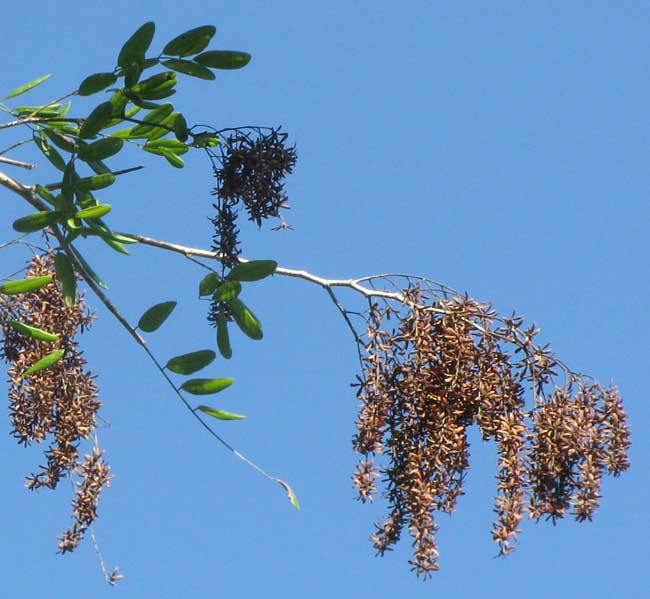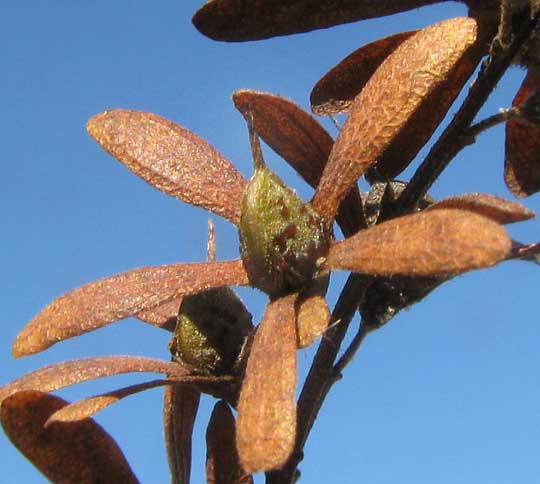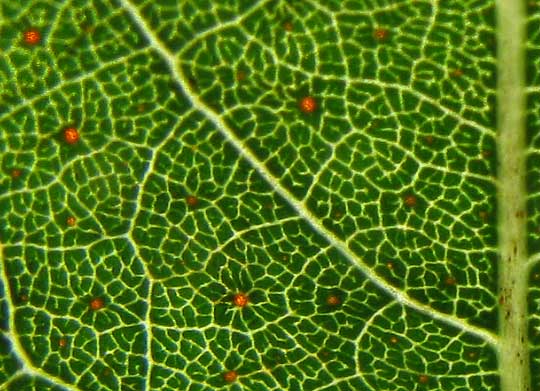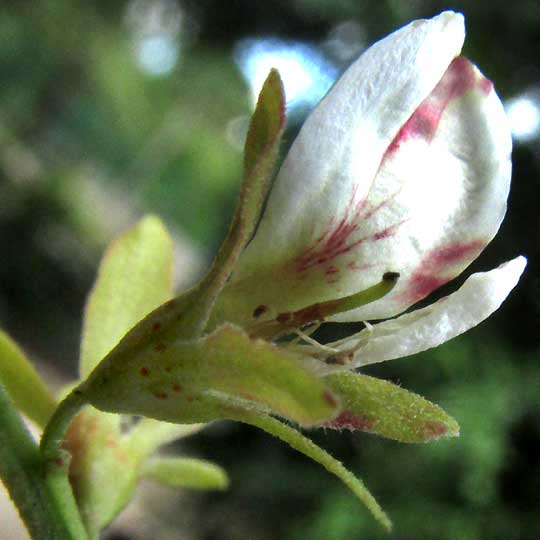Excerpts from Jim Conrad's
Naturalist Newsletter

from the November 22, 2009 Newsletter issued from Hacienda Chichen Resort beside Chichén Itzá Ruins, central Yucatán, MÉXICO; limestone bedrock, elevation ~39m (~128ft), ~N20.676°, ~W88.569°
KIKCHÉ
Another very common small tree is calling attention to itself these days not because its flowers are so pretty but rather because its massive, brown fruiting clusters are so messy looking -- as shown above. Northerners will think the tree's pinnately compound leaves look a lot like those of Blacklocust trees, and that's not a bad observation since this is Kikché, sometimes called Palo de Arco or "Bow-wood", APOPLANESIA PANICULATA, a member of the Bean Family, like Blacklocust.
If you look closely at the brown masses of fruits you'll see that something pretty is going on at a small scale, despite the large-scale messiness, seen below:

What you have there is a single oval, olive-brown, one-seeded fruit at the base of which five reddish- brown, veiny, leathery, elongate lobes emerge, like the arms of a star. Each lobe is a much enlarged sepal, or calyx segment. During flowering, the sepals looked more or less normal, but once pollination occurred and the corolla dropped off, the sepals grew like crazy until they formed this starry collar below the fruit. That's pretty unusual but a few other species do it in various plant families. I think the lobes help disseminate the fruits by wind. Sepals expanding after flowering are said to be "accrescent."
The fruit is a one-seeded legume. Most legumes contain several seeds in a row, so this is another unusual feature. On the legume, notice the dark brown bumps. Those are glands, and in fact the tree has lots of glands, something again a bit unusual for a tree in the Bean Family. Look at the brown glands embedded in a veiny leaflet held up against the sun below:

Aromatic oils in those glands must be the source of the fragrant, spicy odor smelled when Kikché's leaves are crushed between fingers.
All those unusual features have made it hard for taxonomists to figure out how to classify Kikché. Before it was assigned to the genus Apoplanesia it was placed in Eysenhardtia and Microlobium.
In Maya "kik" means "blood" and "ché" means "wood," so this is the "Bloodwood Tree," so named because if you hack the slender, scaly-barked trunk with a machete it exudes reddish sap. María Luisa Vázquez de Ágredos Pascual's fascinating Los Colores y las Técnicas de la Pintura Mural Maya, available as a free PDF download on the Internet (Google the name for the link), lists Kikché as one of the most important sources of the ancient Mayas' red dyes for mural painting.
from the August 23, 2015 Newsletter issued from Yaxunah, 20kms southwest of Chichén Itzá; elevation about 300m (100ft), N20.538°, W88.678°, Yucatán, MÉXICO
SHOWERS OF KIKCHÉ FLOWER-PETALS
Around noon, resting my eyes from the computer screen, a glance between the poles of the hut's walls showed what looked like small snowflakes lightly drifting to the ground. It was white flower petals, though, so the question was, what species nowadays is flowering so prolifically that it can produce such a shower of petals?
The ground outside the hut's door was speckled with petals looking like slender, white fingernail clippings. The flowers shedding the petals were easy to spot, despite being massed so far up atop a nearby tree. One branch lower down also was flowering, and you can see it below:

The flower clusters look yellowish instead of white, as expected because of the white petals. Up close, though, you understand: Most flowers in the picture have lost some or all of their white petals, leaving only the maturing fruits and their yellowish-green sepals. Maybe because nowadays most afternoons we have showers or downpours that beat upon the flowers, on this branch it was hard to find a single blossom retaining all its petals. Many blossoms bore just the large petal at the top, (the "standard," or "banner," in Bean Flower terminology, and this is clearly a bean flower). Below, you can see a flower with its standard and one narrow "wing":

Three features are worth noting on that blossom. First, though the slender "wing" petal is all white, the big banner bears raspberry-color blotches. Also, the green calyx tube bears similarly colored, wartlike glands, and; the sepals are unusually large, and broadest at or above their middles.
The oversized, paddle-shaped (obovate) sepals and raspberry-colored glands reminded me that I knew this tree. In November, 2009 we saw Kikché, Apoplanesia paniculata, heavily laden with crowded clusters of tan-colored fruits, each small fruit bearing five much-enlarged, papery, paddle-shaped sepals, which apparently served for wind dissemination. The tree's small, one-seeded legumes were freckled with tiny, raspberry-colored glands just like the ones on our flower's calyx. Kikché's one-seeded legumes, oversized sepals, and its raspberry glands, are very peculiar for the Bean Family.
We didn't get to see flowers on our fruiting 2009 tree, so now it's good to meet them. When I arrived in Yaxunah three weeks ago another big Kikché at the Community Center was dropping a heavy crop of five-winged legumes, so -- also remembering that our 2009 tree was fruiting in November -- my impression is that Kikché can flower and fruit throughout the year.
The red glands remind us of an interesting feature of Kikché: A machete chop into its trunk brings forth a reddish sap. In ancient Maya times Kikché was one of the most important sources for a red dye used for painting murals.